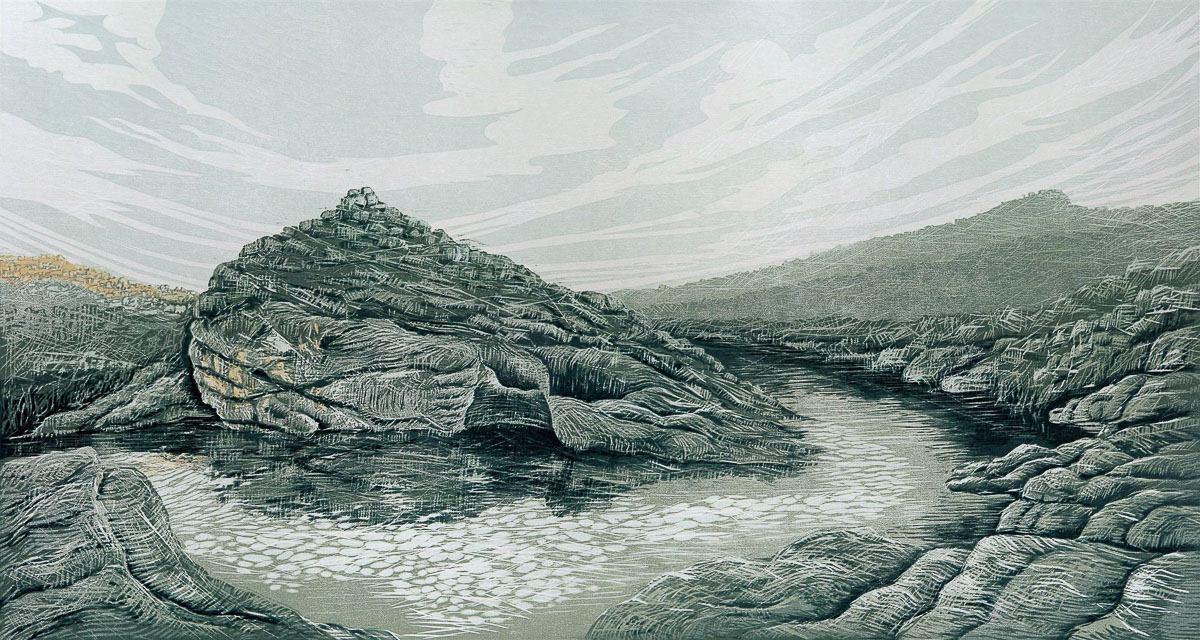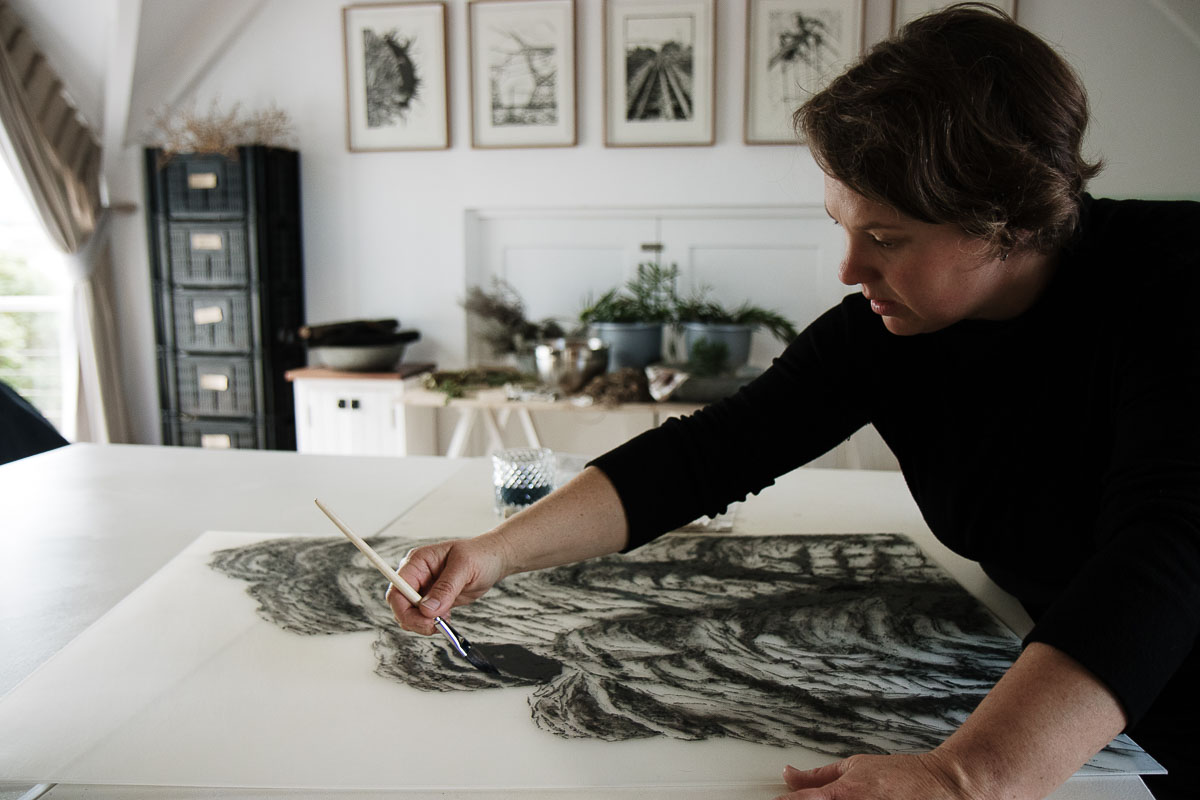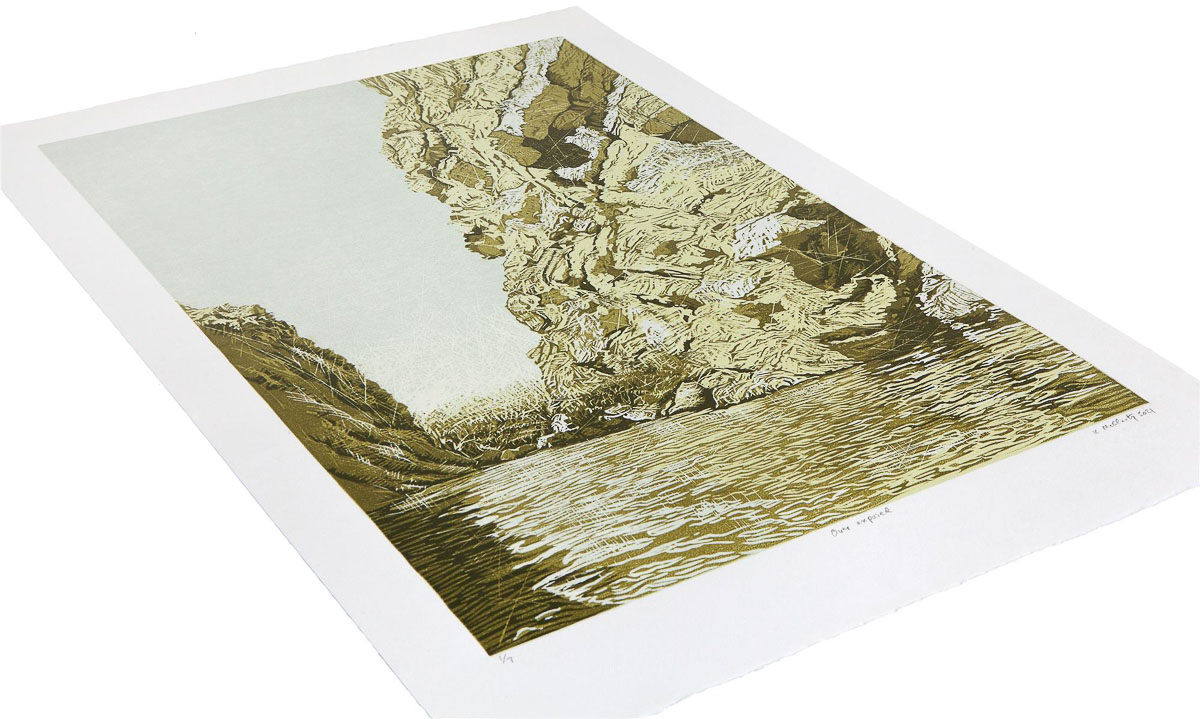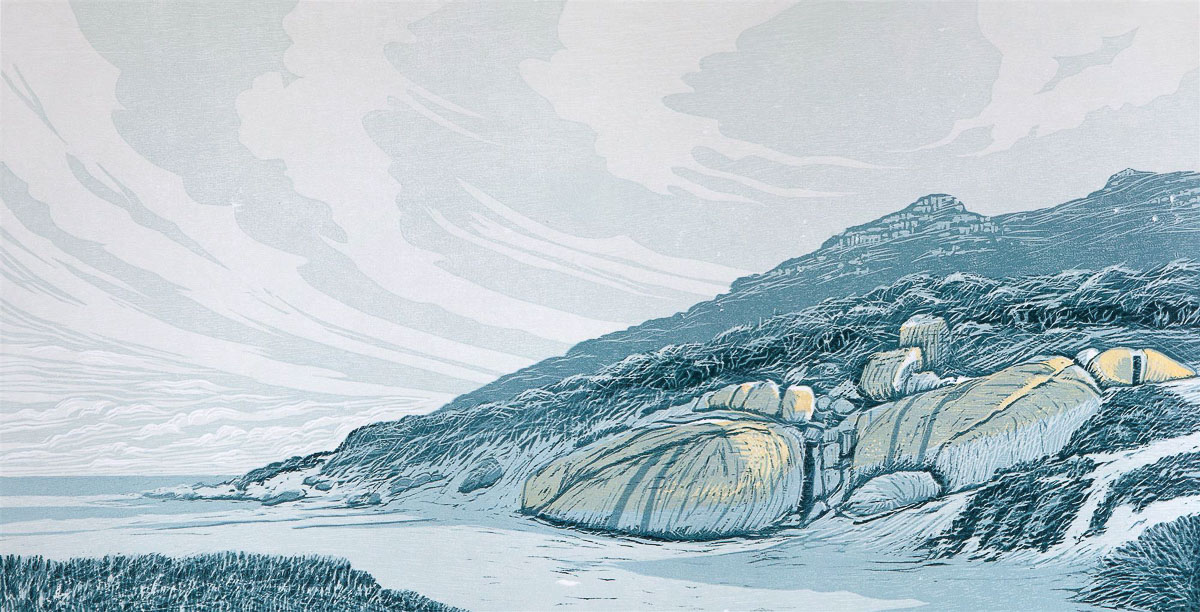For the StateoftheART Gallery Award 2021, we asked artists to find ways to engage with the reality of climate crisis and its impact on their own community; to create work to inspire and encourage societal change. The 10 finalists were chosen from more than 600 submissions from across South Africa, with the judges scoring the artists on the creativity, originality, and technical skill of their entries to this year's Award theme ‘On The Brink, Visualising Climate Change’.
The work of the shortlisted artists will go on show in a special exhibition at StateoftheART’s Cape Town gallery from 16 - 30 October 2021, and the winner announced at the Award Ceremony on 16 October 2021. The winner will receive a R40 000 cash prize and a solo exhibition with the gallery in 2022.
We asked the top ten Gallery Award Finalists some questions to help you get to know them before the Finalists Exhibition in October.
Learn more about the StateoftheART Gallery Award here>>

"A Monday Morning Embrace" by Kristen McClarty. 8 layer reduction woodblock print - oil based ink on Fabriano Tiepolo (295 gsm cotton paper), 97.5 cm x 59 cm
Kristen McClarty:
I am a self-taught artist working out of my studio in Kommetjie. I grew up in Zululand in a creative maker home. I started painting (and textile/stitched work) at a young age. Despite my love for art, I studied and practiced tax law for 14 years, working in large professional firms. I left the corporate world in 2009 to refocus on family and art.
I painted my surroundings in acrylic, plein air or from my photographs, combining painting with my own poetry. A commentary on the past and present of the space. I started printmaking in early 2016, printing with Alma Vorster. Since 2017 I have worked independently, joining The Printing Girls in early 2020. My focus has been on relief and dry point intaglio, with a dabble in monotype.
In January 2021, I moved to woodblock and I think it is where I’ll stay. Process and authentically connecting with my materials is important to me. I must see the evidence of the wood in my print. I bow down to the natural grain and choose a block to best show off what I plan to carve on it. I believe in the connection from the eye to the brain and through the hand, to the plane that I work on. A translation and transfer of my energy to the piece of art.
1. Tell us about yourself. Where are you from, and where do you currently live?I grew up in the small town of Empangeni and spent high school and university in Pietermaritzburg. So, I am a KwaZulu-Natal girl by nature, despite having lived in Cape Town for my adult years. We have been in Kommetjie for 11 years – a hub of creativity and outlandish thoughts in a wild and sometimes harsh coastal setting.
2. How did you learn about the Award and what made you want to enter?Fellow Kommetjie artist, Laurel Holmes, suggested I enter at the beginning of last year. I have been skirting around the idea and the theme since then. Initially, I was relieved when the age cap prevented me from entering in 2020, and then the world changed and so did the Awards, and so did I. I entered because I felt I was ready to, I was proud of the work I was producing, and I wanted to take my message to the world. The opportunity to present my art and its narrative, in a solo exhibition at StateoftheART Gallery, has ultimately been the driving motivation of my entry.
3. Tell us about where you make your work.I work in my home studio in Kommetjie. But the nature of my art practice means that I spend time outdoors, every day. I use this time to search for things I don’t know are there; absorb what I find and see; photograph and sketch; forage for plants, rusted objects, and other matter for my botanical print work. I bring that back to my studio and translate it into a story or message or feeling, that I present in the form of a woodblock print, a stitched piece or perhaps an abstract landscape made from the pigments and textures of plants - colour on a cellular level.
4. What is your key inspiration as an artist? My inspiration is what I experience, feel, and see in a space. My objective is to translate that intimate connection with my environment, into a piece that talks for me. The function of my art is to share that connection with a person, who may or may not have had a similar experience, but who nevertheless recognises the silence, peace, anxiety, confusion, awe, hopelessness, or inevitability of the moment.

Kristen McClarty in studio.
5. Do you have any rituals or habits involving your art-making that you can tell us about?I tend to have periods of intense art making followed by time spent in consolidation, thought and planning. I work in series, revisiting a space or an idea until I have exhausted it. I will approach the subject from different angles, sometimes using similar source material, but treating it in a different way. Or I will separate out the idea into elements and tackle each as a piece of art. I will present my thinking in as large a format as I can manage in my studio, and then I will shrink it down to its essence and tell it again. I think I do this to feel the edges of the idea. Sometimes I will circle around and tackle the same thought again.
6. How does your work convey the threat that climate change poses to our planet and country?My work draws attention to an intimate connection with our surroundings and environment. A connection that has been lost by many, in a world that values things that are man made and expensive and fast. My work, across all media, pulls the viewer back to a place where the hand of man seems irrelevant. Places that eschew the modern lifestyle. Where the heat of the earth or the icy cold of the water, or the last light on a ridge, or the lifting spiralling clouds are so dominant that we are forced to reconsider our place and our role and our choices. My work reminds the viewer of where they stand in relation to the earth.
My art process is deeply rooted in the natural environment. It all starts with my relationship with the earth and the space that I am in, the flora and fauna and shape if it. The light and shadow and movement of clouds through the sky or water around a massif. The translation of this into a woodblock print, carving into a block of wood that was once a tree, is an immersive experience. I work with the natural texture and knots, choosing a block accordingly and following the lay of the grain, carving upside down at times to avoid fighting against it. The woodblock itself becomes a progressive carved art piece, reaching its pinnacle on layer 5 or 6 and then slowly becoming depleted, until all that is left is the surface of the darkest areas of the print. The finished blocks surround me in my studio, memories of the pieces carved.
My botanical contact print process uses the pigment in the cells of leaves and bark and other natural matter, to permanently stain a piece of cloth. Colour packaged in the tiniest cellular containers, the building blocks of what surrounds us, innate and there for our use. My abstract landscapes, printed off plants, with a remarkable range of texture and colour, are a memory of a moment, laying what I have foraged onto a cloth that can be shared, moved, used. This part of my art practice cannot be undertaken without the knowledge of plants and seasons, the role of the moon phases on sap levels, the impact of a storm, the role of the soil make-up in the place a plant grows. Each of these things will influence a print and this makes it inevitable that I become ever closer to my natural environment. The diligent recordal of each print, the plants used and the circumstances, becomes a way of slowly building a library of information that I revisit and use.
7. How is your work relevant in a South African context? I feel that my work is relevant because it addresses these thoughts and ideas, in a South African milieu. It presents a connection with our own land and our spaces. It asks the viewer to discover that place that calms their racing thoughts and makes the world drop away. It challenges the viewer to revalue these spaces and make the choices that will allow generations of South Africans to connect with our land, in the intimate way that my work portrays.

"Over exposed" by Kristen McClarty. 8 layer reduction woodblock print - oil based ink on Fabriano Tiepolo (295 gsm cotton paper), 48 cm x 70 cm.
8. What do you think is the most urgent action required to tackle climate change in South Africa?In my view, the first step is awareness. Awareness of our surroundings and environment, and a drive to reconnect our people to the land. As artists, we need to reawaken the learned and inherited knowledge, that ties people to the earth: when to plant; when to harvest; the optimum time to fell a tree or forage plants for pigment; what plants belong here and what plants don’t; what practices damage the land and what preserves and builds and nourishes.Art needs to remind people of the places that are within their reach. That they can be enjoyed, and they must be held and valued. Only then, can we expect South Africans to make choices to preserve the environment. Only then will the population put pressure on government and legislation to choose fuel and transport and packaging and living in a way that arrests and reverses the damage we have done to our environment, and the inevitable impact on our climate.
9. Which South African artists, organisations or environmental activists do you find inspirational at the moment and why?There are so many people and organisation who make a difference, but I will focus on those that press my buttons. These are people who inspire me:Local Kommetjie resident Regardt Kenny of Ecowerks – for his alternative building practices, use of Hempcrete, and his rainwater harvesting systems that challenge our perceptions of how to use water and what is reasonable. Regardt installed rainwater tanks at our home 3 years ago and we have used this water exclusively for our washing machine since then, through the drought. Small changes, big impact.Cape Town photographer Jean Tresfon – he uses and shares his photography to highlight the status of the land and oceans, fish stock, breeding and legal/illegal fishing. Ultimately, sharing the impact of the changing climate on the South African land and seascape.Cape Town endurance swimmer and ocean advocate Lewis Pugh – a man who lets nothing get between him and the environment, except a brief swimsuit. He raises awareness of climate change and the impact on the very ends of the earth, by immersing himself in it. Immensely brave.Conceptual artist Emma Willemse – for her work that captures the connection between people and their homes and the devastating loss of displacement. Her work produces a visceral response in me, shortening my breath and bringing on thoughts of hopelessness. This displacement has parallels in the loss that will result from the way that we treat the natural environment – like it has no value. Things that cannot be undone. The Cape Parrot Project working with corporates who fund the Reforestation Project, to reintroduce indigenous Yellowwood forests to areas such as Hogsback in the Eastern Cape. In so doing, they are providing work and an income to the local rural community: baby-sitters of the saplings until they are large enough to plant. And crucially, they are providing food to the Cape Parrot – an endemic endangered species that is often overlooked. The forests have been decimated since colonisers arrived in the Cape. These projects seek to reverse the damage. I have been privileged to work with one of the corporates involved, using my art to highlight this project.
10. How do you feel about the upcoming group exhibition and the other shortlisted finalists’ works? The diversity of the work of the finalists will, in my view, make for an exceptional exhibition of wall art and three-dimensional structures. Perhaps an audio visual component. I have followed the journey of each of the artists, to the extent that this is available. One of the artists whose work I find fascinating, is Zanoxolo Sylvester Mgqeku. The earthy symbolism of the external surface of his sand cast ceramic structures speaks of meteorites fallen from space. Or a medieval grenade. But at the same time, a deep seated connection with ground and earth. In one of his posts, he talks of his Memory going back 30 000 years – an ingrained relationship with the earth, allowing it to talk through him and come to the fore.
This deep and authentic connection with the earth is something that I also see in Dominic De Villiers. As he is one of the three Kommetjie artists in the group of finalists, I have a natural interest in him and his work. Meeting him at his home and the place he makes some of his art, I found a young man who has allowed the confines and expectations of modern existence to slip away, leaving a person who is in tune with the natural rhythms. He is one of the few people that I have talked to, who is aware that the sap and energy in plants rises with the full moon, in the same way that the tide does, making that the optimum time to fell saplings for woven structures or forage plants for printing (as I do). His conceptual work makes you think, and I am hoping his film will be projected in the space of the exhibition, as layering the audio visual, along with the other work, will add depth to the experience.
Janet Ormond is an environmental activist who has transitioned, in the time that I have known her, into an environmental artist. She produces artwork that displays exquisite detail, sensitive composition, and an awareness of the places around us. The pieces that she submitted show exceptional observation. The Top 10 Finalist Award and Exhibition will hopefully give her access to exhibiting in more galleries and raise awareness of and interest in her work. Quite importantly, it will make it clear that her work has transitioned from skilled craft to art, with the associated and necessary intention.
All the artists display skill and interesting thought, and it would be wonderful to get to know each person, as I expect there will be a thread that ties us together. Personally, this process has been an extremely emotional one. It has been an affirmation of the development of my work over the last year or two, and I am so excited to be exhibiting these pieces. I am hoping that the love shown by people who I know, and those who follow my work process on social media, will translate into some serious interest in the finished art.
11. What do you think of the StateoftheART Gallery Award as a platform for emerging artists in South Africa?The StateoftheART Gallery Award provides an artist with the opportunity to test their concepts and work, against the market and other artists, and gives them an opportunity to take it out there. Since the Gallery has such a strong online presence, the market reach is not limited to visitors, but extends nationally and indeed internationally.
The Award gives an artist the opportunity to learn the more commercial elements of art making and selling. This is quite important, as it takes a team effort between the Gallery and artist, to take the art to the market. It gives crucial exhibition experience to those who don’t have it. An understanding of the process and many elements that need to come together to make for a successful show.
Most importantly, the Award means that an artist has someone in their corner. This has been shown to really launch an art career. It has made the career of the previous winners, in my view. Without this recognition, there is a real struggle to find exposure, get in front of the right people, connect, network, remain confident in the work, and this continues, making it inevitable that only the most resilient find some ongoing career success as an artist.Obviously, this Award is not a magic pill. It will only serve as a platform for an emerging artist who puts in the work and partners with the Gallery to take it out there.

"A Thursday Morning" by Kristen McClarty. 7 layer reduction woodblock print - oil based ink on Fabriano Tiepolo (295 gsm cotton paper), 67 cm x 41cm
12. If you win the Gallery Award, tell us about what you have in mind for your solo exhibition in 2022?I have something in my head that is quite fully developed and will be the bones of my first solo exhibition, hopefully in 2022 but if not, then soon thereafter.The idea pulls together a few thoughts. Firstly, a place or space (as I like to call it) holds much more than the present. It holds memories of the aeons, as it slowly evolved to be what we see today. Besides the environmental changes that it has seen, it has also felt the presence of humans. People who are at peace and those who are at war. Indiscriminate and intimate violence has been perpetrated. People have passed through, and some have stayed. They have lived there, maybe loved there; they have been afraid. As I like to put it, the juices of men and women have seeped into the land, absorbed, marking it forever. This palimpsest of memories is something that interests me. How is it evidenced?
The next thought that comes into play, is that ordinary people have found a way to mark their presence on their surroundings. In the Western Cape, we have the privilege of being able to study the rich history of Khoisan painting and artwork, especially common in the Cederberg, an area that I love and the inspiration of some of my recent work. These paintings depict the mundane and interesting things that happened, recording frustrations and elations and sadness, just as art does today.
But closer to home, another recording is happening, and it continues to develop. All over the city and in places that fall outside of what we would think of as the target area, people, particularly the youth, inscribe things on walls, on rocks, on the road, on trees, on desks, on cars, on private and public property. Basically, on any surface that can take a scratch, a spray, a line. The graffiti that I am interested in, is almost always vandalism. It’s the dirty graffiti that shows little skill on the part of the writer but says all sorts of things. It may include an image and a double line or a halo, but that doesn’t matter to me.
I am interested in the visual demonstration of existence, the subversive word or phrase, the protest, the shout out, the incrimination, the cry for help and the whoop of ecstasy. The word written in shame or after a spliff or too much cheap alcohol or a scary fuck. The words written by young people who shouldn’t be there but tell the world they are there, and they are here, and they exist, and they have thoughts, and they want to tell you or anyone, something. And they don’t have a place to say those things. I am interested in how those things stack up over time and become a palimpsest of marks and colour.
I particularly enjoy the juxtaposition of the natural environment, with a place such as that described. Perhaps it’s a crumbled building or a doorway with no door. Perhaps the cliffs are visible, and we can also see the dirty graffiti, marking the existence of countless ordinary people. Thoughts and words that are illegal and shouldn’t be there and are not considered art. Park that thought.
(Now, we all know what money laundering is. Dirty money, from nefarious activity, is invested or used in a seemingly legitimate enterprise, and the resulting profits are squeaky clean. There are forensic professionals who spend their lives studying this and trying to catch people out. Pull this idea over to the parked one.)
My next project, which will start quite soon and is already being planned, will be called my Art Laundering Project, until I think of a better name. I plan to use my eye and my hand and my skill and my art, to take the layering of memories and emotions, evidenced by the dirty graffiti that is frowned upon, into the space of my woodblocks, monotype prints, possibly a painting. My botanical contact prints. I want to show how I feel in a space, but I also want to show how others have felt there, and what they have said. Because after all, the space carries all of us.
In terms of media, I plan several large (full size of press) woodblock prints. These would be multiple block and reduction, to allow for the layering of the dirty graffiti into the space. I will most certainly make smaller pieces, as small as 20x20 cm, to provide detailed glimpses into elements I love. Towering rocks, broken bricks, pops of colour, perhaps a word that we don’t want to see. But we should. I’d revisit the spaces with water colour monotype, also on a large scale and ranging down to small. Tiny message cloths, with stitched thoughts, over layered botanical print. Floated and framed. A larger cloth, printed with the pigment of plants foraged in the same area. A laying down of the natural space, onto a textile. Stretched and framed.
My preparation would include time off the path, talking to people, taking photographs, water colour sketches. Repeated visits to the same place. Experimentation with techniques to evidence the idea. Dirty graffiti and our magnificent surrounds, rolled into one and presented as skilled and arresting and beautiful art. Kristen’s Art Laundering Project.
13. Finally, tell us something surprising about yourself.My left knee is titanium, coated with a shiny gold alloy. It’s the only bling that I really like on me and its fortunately not visible.I am an Advocate of the High Court and have practiced Tax Law for 14 years. I have no formal art training but have made art for my whole life, or close to it.

